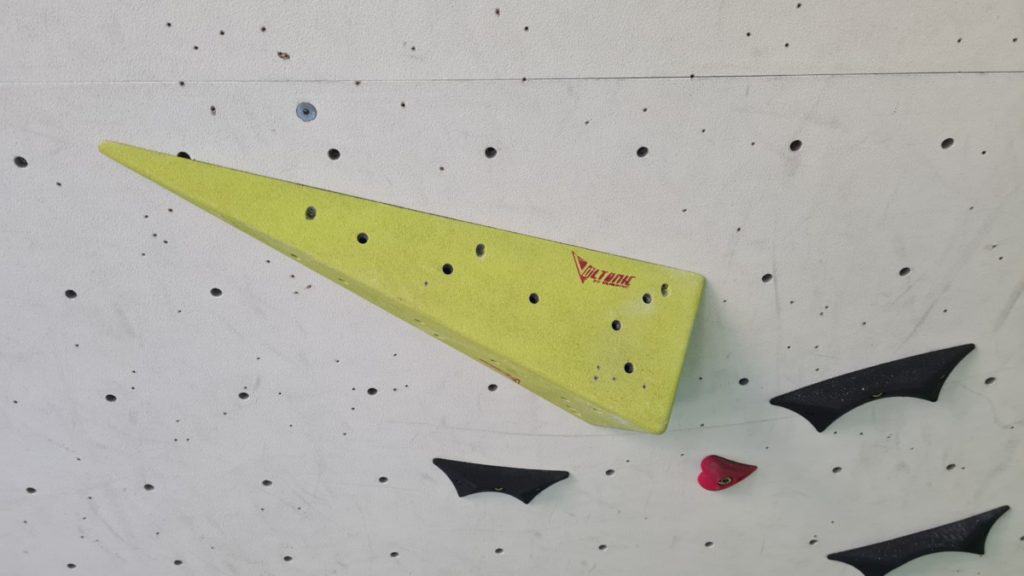
As a beginner I was wondering what these big things on the wall are useful for, because they didn’t belong to any specific climbing route. Then my friends told me what volumes are and how I use them. Ever since then I include them in my climbing whenever possible, as they are very benefitial to use.
Volumes in climbing are prism shaped features that are used as an extension of the wall and can be used as hand or feet holds. They don’t belong to any route and can always be used. Often volumes are made out of wood or fiber and different holds can be placed onto them.
If you climb attentively volumes can be a big help when included correctly into a climbing route or boulder. In the following I will explain how you use volumes to improve your climbing and how they work as a wall extensions and not as a normal hold.
What Are Volumes Used For in Climbing?
Volumes are often a supportive structure on the wall and are not intended to be included in a specific climbing route and are more a part of the wall. The volumes are a natural wall extension and no hold itself most of the times. This should rebuild the natural uneven surface of natural rocks.
As the target of a climbing gym is to recreate the rock climbing experience outdoors, volumes can create a more realistic feeling and add texture and depth into the wall. Most of the times all volumes are in the same colour, so you know that they don’t belong to a climbing route and are more like a part of the wall.
Many times hand and feet holds of boulders are placed onto a volume, because it is treated like a piece of the wall. It’s also possible, that multiple holds from different climbing routes are screwed onto one single volume. Having holds on a volume can change the angle you have to grab them and make the boulder problem more difficult. If you want to know what a boulder problem is and learn how to solve it effectively click here.

Some boulders also have one or more volumes included in the route. This recreates a long edge of a rock here you have to hold on, or a plateau where you can stand on. Maybe you are able to cheat the volumes and don’t have to use them, but try to climb the route like it’s intended of the route setter, as it will be more fun and the grade of the boulder will also be more accurate.
Some climbing routes, especially the very hard ones, only exist out of volumes. This makes the boulder very difficult, because there are no real hand holds, just the edges of the volumes. There are no feet holds aswell in such kinds of boulders and you have to try to stand on the very steep surface of the volumes. If you are atleast intermediate or advanced, try to climb a only volume route if it’s available in your gym. The experience is very fun and unique.
Form and Material of a Climbing Volume
Most of the volmes in the climbing gyms are made out of wood. Wood is very durable and has a nice texture to it. However as the climbing industry is evolving fiber volumes are getting more and more common. They have a rougher surface and because of this a better hold.
However volumes made out of fiber are still pretty expensive, which is why most climbing gyms still use volumes made out of wood. There are also other way more expensive volume types on the market, like dual texture fiber volumes, which have a special smooth and shiny surface, that are very hard to climb.
There is no prescribed form a volume should have, so really every prism you can put on a wall is a volume. The most common form of a volume is the triangle shaped prism. From there on prism in every form, size and colour exist. Every volume is designed for another purpose, so always think about why this voulme has this form and how you should use it, if you see one.

How to Include Volumes in Other Climbing Routes
Volumes are a great help for every climber, as they give you additional surface you can use that isn’t just the straight wall. Especially when a volumes is obviously included in a climbing route you should think about it’s purpose in the route and how you will use it.
Very often, preferably in easier climbing routes, volumes are used as additional feet holds. Because of the big surface of the most volumes you can on them with both feet. In case the volume is very steep try to put your feet parallel to the wall, as this will increase the hold on the volume.
In hard boulders volumes are often used as hand holds. Becaus there is no real hold you can grab at, try to hold the volume along it’s long edge, as this will give you the most grip. Think about it like a long edge that is coming out of a rock, it’s the same principle.
Sometimes volumes can also be placed as obstacles in tricky and hard climbing routes, where you have to push your body around it. The volume is placed between two holds, whch makes it more difficult to reach them. If you are an advanced climber you will see the purpose of the volume in the route and climb around it. If you are not advanced yet, just try to think about this possibility and that volumes are not always your friend.
Final Thoughts
Volumes are great and very often overseen, because they have a different colour than the holds of the route you are currently climbing. Try to open your eyes a bit more and look for volumes. You will often oversee them, altough they make your life a lot easier if you use them.
Maybe try to also read the function of a volume that is near your route before you start it and don’t just look at the individual holds. Maybe you can include the volume and it is helpful.
